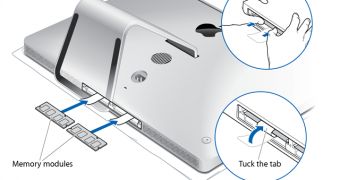Apple has posted new documentation on the Support section of its website, this time stressing what kind of memory its new iMac range uses, as well as outlining the steps for installing or replacing the memory modules.
Apple reveals that the iMac (Late 2009) has four SDRAM slots at the bottom of the computer and comes with at least 4 GB DDR3 SDRAM installed as two 2GB DIMMs into two slots. Support article HT3912 claims that the maximum amount of RAM a user can install in the computer is of 16 GB – as 4 GB SO-DIMMs in each slot.
Ensuring that customers do not buy inappropriate memory for their new iMac, the company lists the Small-Outline dual inline memory modules (SO-DIMMS) that meet certain criteria: PC3-8500; Unbuffered; Nonparity; 204-pin; 1066 MHz; DDR3 SDRAM. RAM module sizes of 2 GB or 4 GB can be used in each slot. Further ensuring that customers don’t make a mistake while purchasing new RAM modules for their iMac, the Cupertino-based company also lists DIMMs that do not work in the iMac (Late 2009). Key features include registers or buffers; PLLs; ECC; Parity; EDO RAM.
The Mac maker then moves to instruct users on how to do the replacing. “Always follow the upgrade instructions for memory installation as written. Never attempt to remove any screws that are not listed in the upgrade instructions,” Apple says.
Support document HT3918 comes with a step-by-step guide complete with imagery showing customers exactly how they need to proceed. Using a Philips screwdriver, iMac owners must remove the RAM access door at the bottom of their computer, then the access door, untuck the tab in the memory compartment to be able to take out the old memory modules, and make the replacement.

 14 DAY TRIAL //
14 DAY TRIAL //